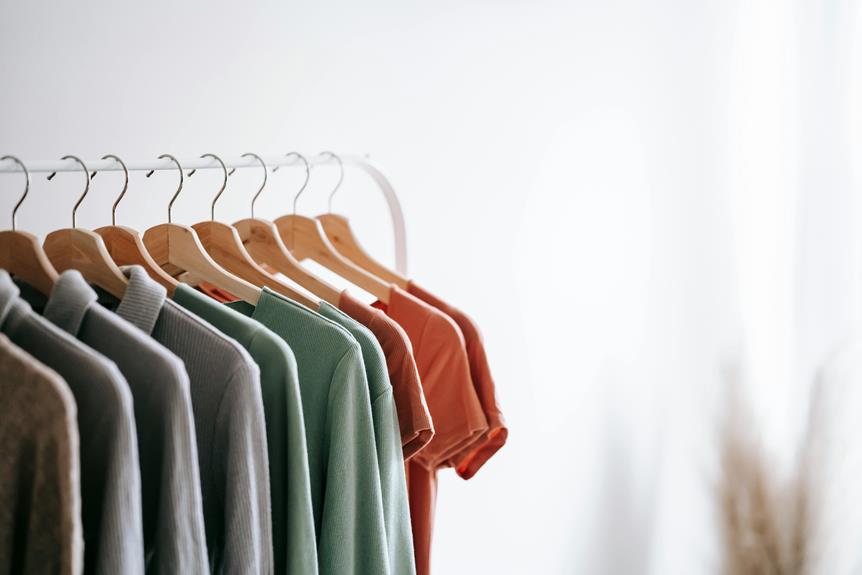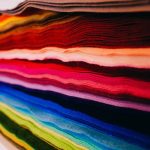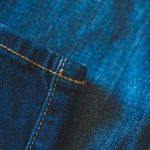When you're choosing between voile and broadcloth, it's essential to consider their unique properties and how they align with your project needs. Voile offers a lightweight, airy feel that's perfect for summer dresses and soft window treatments, while broadcloth provides a structured, durable option for more tailored garments. Each fabric has its strengths, but the decision hinges on what you're aiming to achieve. Understanding the nuances of these fabrics can significantly impact your final outcome, and you might find a surprising twist in their applications that could influence your next creation.
Table of Contents
Overview of Voile
Voile is a lightweight, sheer fabric that's often used for curtains, blouses, and summer dresses, offering a delicate touch and graceful drape. You'll find that voile is typically made from cotton, polyester, or a blend of both, giving it a soft feel while still being durable. This fabric is known for its breathability, making it a favorite choice for warm weather.
When you choose voile, you'll appreciate its versatility. It can be used in various projects, from elegant home decor to stylish fashion. The sheer quality allows light to filter through beautifully, creating a soft ambiance in any room or outfit. You can also layer voile over other fabrics for added texture and depth.
Caring for voile is relatively simple. You can machine wash it on a gentle cycle and tumble dry on low heat, although air drying is often recommended to maintain its delicate nature. If you iron it, use a low setting to avoid scorching.
Overview of Broadcloth
Broadcloth is a versatile, tightly woven fabric that offers a sturdy yet smooth texture, making it a popular choice for shirts, dresses, and home textiles. The fabric is usually made from cotton, polyester, or a blend of both, which contributes to its durability and ease of care. You'll often find broadcloth in various colors and patterns, allowing you to select the perfect fabric for your project.
One of the key benefits of broadcloth is its ability to hold shape well. This characteristic makes it an ideal choice for tailored garments and structured designs. Whether you're sewing a crisp dress shirt or a stylish dress, broadcloth provides the support you need without feeling overly stiff.
Broadcloth's weight is another notable feature. It typically falls in the medium range, making it suitable for year-round wear. You can layer it comfortably in cooler months while still feeling breathable during warmer seasons.
In terms of maintenance, broadcloth is generally easy to care for, often being machine washable and resistant to wrinkles. This practicality makes broadcloth a go-to fabric for both everyday wear and special occasions.
Texture and Feel
When you compare voile and broadcloth, the texture and feel can really impact your choice.
You'll notice that voile offers a softness that's light and airy, while broadcloth tends to be denser and more structured.
Understanding these differences can help you decide which fabric suits your needs best.
Softness Comparison
You'll find that the softness of voile typically offers a delicate, airy feel, while broadcloth presents a smoother, denser texture. When you run your fingers over voile, you'll sense the gentle, almost ethereal quality that makes it perfect for light, flowing garments. In contrast, broadcloth gives you a more substantial touch, ideal for structured pieces that require a bit more durability.
To help you visualize the differences, here's a quick comparison:
| Fabric | Softness Level | Feel |
|---|---|---|
| Voile | High | Delicate and airy |
| Broadcloth | Medium | Smooth and substantial |
| Overall | Varies | Depends on weave and finish |
Choosing between these fabrics really comes down to your desired experience. If you want something that floats and feels like a whisper against your skin, go for voile. But if you prefer a fabric with a more pronounced touch, broadcloth will deliver that cozy, comforting embrace. Your choice will ultimately reflect your personal style and the effect you want your fabric to convey.
Breathability Levels
Breathability plays a crucial role in how comfortable each fabric feels against your skin, particularly in warm weather.
When you wear voile, you'll notice its lightweight and airy texture allows for excellent airflow. This makes it a popular choice for summer dresses and blouses, as it helps keep you cool during hot days. The loose weave of the fabric enables moisture to escape quickly, preventing that sticky feeling that can occur with less breathable materials.
On the other hand, broadcloth has a tighter weave, which can affect its breathability. While it still offers decent airflow, it doesn't compare to the lightness of voile. You might find broadcloth more suitable for structured garments, like dress shirts or tailored pants, where a crisp look is essential, but it might feel warmer against your skin in high temperatures.
Ultimately, if you're prioritizing breathability, especially for summer outings, voile is your go-to option. It'll keep you feeling fresh and comfortable. If you prefer a more polished look, broadcloth serves well, just keep in mind its slightly reduced breathability in sweltering conditions.
Weight and Drapability
When choosing between voile and broadcloth, you'll notice distinct differences in weight that affect how each fabric drapes.
Voile is lightweight and flows beautifully, while broadcloth offers a more structured feel.
Understanding these characteristics will help you select the best fabric for your project.
Fabric Weight Comparison
Understanding the weight and drapability of voile and broadcloth can help you choose the right fabric for your project.
Voile typically weighs less than broadcloth, making it a go-to option for lightweight garments and airy designs. You'll find that voile has a delicate, sheer quality that's perfect for layering or creating flowing silhouettes, while broadcloth offers a sturdier, more substantial feel.
When you're considering the weight, remember that broadcloth's density provides more structure, making it ideal for shirts, dresses, and home decor items like curtains or cushion covers. If you need a fabric that holds its shape, broadcloth's heavier weight is a better match for your needs.
On the other hand, if you're aiming for something soft and billowy, voile's lightness will give your project a gentle drape that moves beautifully. This difference in weight can significantly affect how your finished piece looks and feels.
Drapability Characteristics Explained
Drapability plays a crucial role in how your fabric behaves in motion, influencing the overall look and feel of your finished project. When you choose fabrics like voile or broadcloth, understanding their drapability characteristics can significantly impact your design choices.
Here's a quick comparison to help you visualize:
| Fabric Type | Weight Category | Drapability Level |
|---|---|---|
| Voile | Light | High |
| Broadcloth | Medium | Moderate |
| Voile | Light | Flowy |
| Broadcloth | Medium | Structured |
Voile, being lightweight, tends to drape beautifully, creating soft, flowing lines that work well for garments like skirts and blouses. You'll notice how it moves gracefully with your body, enhancing your silhouette. On the other hand, broadcloth offers more structure due to its medium weight. It holds its shape well, making it ideal for tailored pieces or home decor.
In essence, consider how each fabric's weight and drapability aligns with your project's goals. Your choice will not only affect the final look but also the comfort and functionality of what you create.
Best Uses for Each
Choosing the right fabric for your project hinges on how well its weight and drapability match your intended design.
When you're working with voile, consider its lightweight and sheer qualities. This fabric shines in projects like flowing summer dresses, soft blouses, or delicate curtains where you want a gentle drape and airy feel. Voile's ability to create soft layers makes it perfect for garments that require a bit of movement and elegance.
On the other hand, broadcloth is a heavier fabric with a crisp finish, making it ideal for structured garments. If you're sewing tailored shirts, crisp dresses, or even home décor like tablecloths and pillowcases, broadcloth's sturdiness and smooth surface work well. It holds its shape beautifully, giving a more polished look to your projects.
Ultimately, think about the function and aesthetic of your design. Voile offers a light, ethereal vibe, while broadcloth provides structure and durability. By evaluating these key characteristics, you'll find the perfect fabric to bring your vision to life.
Make your choice based on the weight and drapability that best suit your creative needs.
Common Uses and Applications
Voile and broadcloth each serve distinct purposes in the world of textiles, making them popular choices for various projects.
When you're looking for a lightweight, airy fabric, voile is your go-to option. It's perfect for creating flowing dresses, blouses, and curtains that let in light while maintaining a touch of privacy. You'll also find voile commonly used in home décor, like sheer window treatments or delicate table linens, adding elegance to any space.
On the other hand, broadcloth is your best bet when durability and versatility are key. This fabric's tightly woven structure makes it ideal for shirts, dresses, and even tailored garments. You can rely on broadcloth for its crisp finish, making it suitable for both casual and formal wear. It's also a popular choice for quilting projects, as it stands up well to multiple washes without losing its shape.
Care and Maintenance
When it comes to caring for voile and broadcloth, understanding their unique characteristics is essential for maintaining their appearance and longevity.
Voile is lightweight and delicate, so you'll want to handle it with care. Always wash it in cold water on a gentle cycle to prevent damage. Avoid bleach, as it can cause discoloration. If you're air drying, lay it flat or hang it to minimize wrinkles, and iron it on a low setting if needed.
Broadcloth, on the other hand, is more durable and can withstand a bit more wear and tear. You can wash broadcloth in warm water, and it generally does well in the dryer. However, to ensure the fabric stays crisp, consider removing it from the dryer while it's still slightly damp and ironing it to achieve a smooth finish.
For both fabrics, store them in a cool, dry place, away from direct sunlight to prevent fading. With these care tips, you can keep your voile and broadcloth looking fresh and vibrant for years to come.
Choosing the Right Fabric
Understanding the differences between voile and broadcloth can help you decide which fabric best suits your needs for a specific project or application. Both fabrics have unique qualities that make them suitable for different uses, so consider the following factors before making your choice:
- Weight and Drape: Voile is lightweight and has a soft drape, perfect for flowy garments. Broadcloth is heavier, giving it a structured feel ideal for shirts and dresses.
- Transparency: Voile is semi-sheer, which works well for layering or creating delicate curtains. Broadcloth is opaque, offering more coverage.
- Texture: Voile has a soft, smooth texture, while broadcloth features a crisp, slightly textured surface.
- Durability: Broadcloth is generally more durable and resistant to wear, making it suitable for everyday clothing. Voile, while beautiful, may require more careful handling.
Ultimately, think about the specific look and functionality you want for your project.
Whether you lean towards the ethereal feel of voile or the classic sturdiness of broadcloth, your choice will significantly impact the final product.
Frequently Asked Questions
Can Voile and Broadcloth Be Blended With Other Fabrics?
Yes, you can blend voile and broadcloth with other fabrics. Mixing them can enhance texture and durability, creating unique combinations for various projects. Just ensure the fabrics complement each other for the best results.
Are There Eco-Friendly Options Available for Both Fabrics?
Yes, you can find eco-friendly options for both fabrics. Look for organic cotton, bamboo, or recycled materials. These alternatives not only reduce environmental impact but also offer the same qualities you love in traditional fabrics.
How Do Color Options Differ Between Voile and Broadcloth?
When choosing fabrics, you'll notice that color options can vary significantly. Voile often features lighter, softer shades and prints, while broadcloth tends to offer bolder, more vibrant colors, giving you unique choices for your projects.
What Are the Historical Uses of Voile and Broadcloth?
Historically, you'll find voile used in lightweight garments and curtains, while broadcloth's often been favored for shirts and formal wear. Each fabric's unique characteristics suited various needs throughout the years, shaping their popular applications.
How Do Fabric Certifications Differ for Voile and Broadcloth?
You'll find that fabric certifications vary based on the manufacturing processes and materials used. Each type of fabric often adheres to different standards, affecting quality, sustainability, and safety, which can influence your purchasing decisions.
- How Does Ring Spun Cotton Affect Garment Fit and Shape Retention? - August 13, 2024
- What Are the Challenges in Producing Ring Spun Cotton? - August 13, 2024
- Is Ring Spun Cotton Suitable for Plus-Size Clothing? - August 13, 2024







